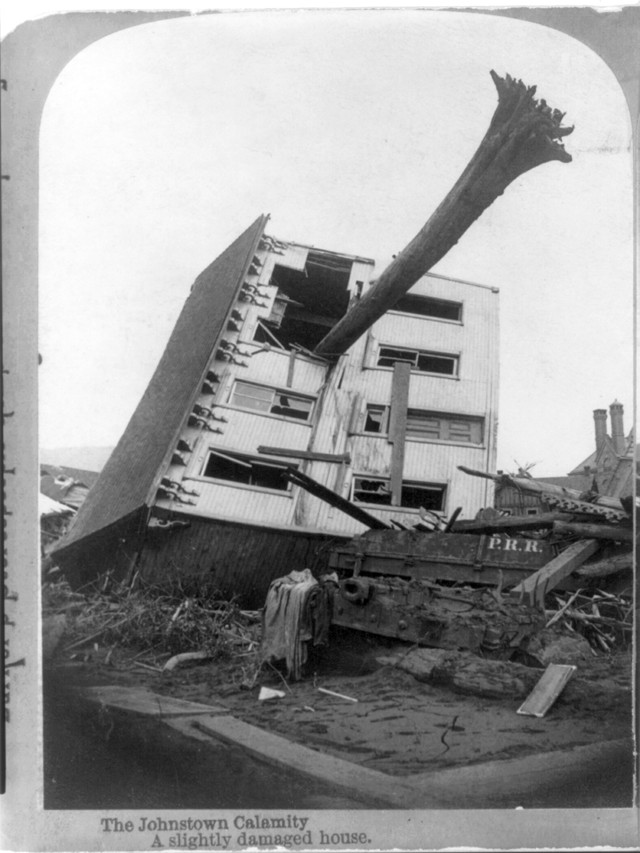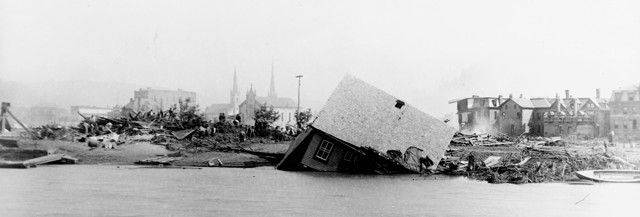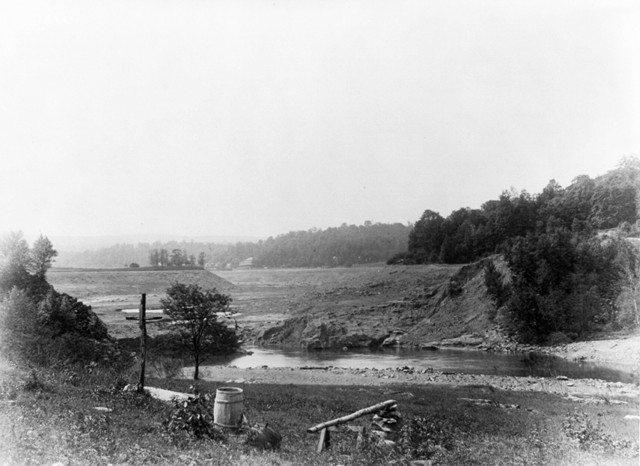
by Sam Lemonick Thursday, June 23, 2016

The Johnstown Flood caused an estimated 7 million in property damage. Credit: ©George Barker, courtesy of Library of Congress Prints and Photographs Division.
“It seemed to me as if all the destructive elements of the Creator had been turned loose at once in that awful current of water.” That’s how Col. Elias Unger, president of the corporation that maintained a dam and resort property called the South Fork Fishing and Hunting Club, described the water unleashed on the afternoon of May 31, 1889, when a dam at the club broke 23 kilometers above Johnstown, Pa. A little more than an hour later, a wall of water reached the town. In all, more than 2,200 people died in what is known as the Johnstown Flood.
The flood’s immediate cause was historic rainfall that started late the day before. Some 15 to 20 centimeters of rain fell in the region over 24 hours, with as much as 25 centimeters in some places. Water ran into the region’s rivers and streams, such as the South Fork Creek and the Conemaugh River. Water from South Fork Creek collected in Lake Conemaugh behind the South Fork Fishing and Hunting Club’s dam. Estimates put the lake’s contents at more than 5 billion gallons, or about 8,000 Olympic-sized pools. After a night of rain, the lake’s level rose another meter, adding unknown stress to the earthen dam holding the lake back.
If the rain directly caused the flood, the dam — and human intervention or lack thereof — led to the disaster. The dam was built in the mid-19th century by the state to ensure a constant source of water for the section of the trans-Pennsylvania canal system that carried people and goods such as coal and steel between Johnstown and Pittsburgh, important coal-mining and steel-making cities in southwestern Pennsylvania. Finished in 1852 after 14 years of halting work, the completed dam was a mound of clay buttressed with rocks, measuring 22 meters high and 280 meters across. From a thickness of 82 meters at its base, the dam narrowed to about 6 meters at its top. A spillway was cut into the hill to the north of the dam. The dam sat across the South Fork Creek, creating Lake Conemaugh a few kilometers upstream from where the creek met the Little Conemaugh River.

Devastation in Johnstown. Credit: ©Ernest Walker Histed, courtesy of Library of Congress Prints and Photographs Division.
From completion in 1852 until it broke in 1889, the dam changed hands several times and fell into disrepair for long stretches. Less than a year after the dam was completed, the Pennsylvania Railroad made its first run between Philadelphia and Pittsburgh, putting the canal system out of business. The railroad acquired the canals — and the dam — from the state a few years later to use the rights of way. Having no use for the water, the company let the dam sit until it sold the land 22 years later.
During that time, the dam experienced its first problem. In 1862, the dam failed at the sluice pipes in its base that controlled the flow of the creek. But because the lake was only half full at the time, there was little damage from the failure. The rupture was never repaired and the lake sat empty.

The remains of Lake Conemaugh and the South Fork Fishing and Hunting Club's dam. Credit: ©Langill & Darling, courtesy of Library of Congress Prints and Photographs Division.
In 1875, U.S. Rep. John Reilly from Pennsylvania purchased the property that included the dam and then-empty lake from the railroad. Four years later, he sold the property to Benjamin Ruff, an entrepreneur from Pittsburgh with a plan to create a summer retreat for wealthy Pittsburghers. Ruff rebuilt the dam haphazardly, closing the hole left by the earlier break with brush, mud and even manure. The work was not overseen by an engineer.
Ruff opened the South Fork Fishing and Hunting Club in 1879. The club was a who’s who of Pittsburgh business figures of the time. Steel magnate Andrew Carnegie was a member, as were Henry Frick, Carnegie’s successor at U.S. Steel, and financier Andrew Mellon. Although the courts later ruled that the flood was an “act of God” and assigned no blame to the club or any of these men, in the flood’s aftermath, investigations by newspapers found that the club had never inspected the dam. Moreover, many believed that Ruff’s repairs fatally compromised the dam’s integrity.
Ruff made several alterations to the dam during his rebuild that may have contributed to its collapse, newspapers reported at the time. First, Ruff failed to replace the sluice pipes in the dam’s base. Without them, there was no way to control the height of the water behind the dam. Second, the dam was lowered by more than a meter to allow a road to be built across it. Although it may not seem significant compared to the dam’s overall height, it meant water would top the dam that much faster in a flood. The lake’s normal level was reportedly little more than a meter from the dam’s crest during the South Fork Club’s time.
There were other reported flaws as well. To protect the stock of fish the club had added to the lake, Ruff put a screen of metal rods over the top of the spillway. This became clogged with debris over time, contributing to the speed with which the water rose. Ruff also had failed to rebuild the dam to its full height in the center. And when the club refilled the lake, they let the water rise much higher than the state had planned when the dam was built. Together these changes stressed the dam beyond its design and narrowed the margin of error for a disaster, newspapers reported at the time.
On May 31, the day of the flood, there were several warnings that the dam might fail from people who had hiked up to look at it. Early in the day, telegraphs were sent from South Fork to Johnstown and other towns, but because wires had been brought down by the rain, the messages didn’t reach Johnstown until a little over an hour before the water hit.
The message did make it to John Walkinshaw, a railyard manager in East Conemaugh, a town four kilometers upriver from Johnstown. But he never passed the information along to the villagers; it’s still unknown whether the breakdown in communication was because Walkinshaw was simply overwhelmed by responsibilities at the yard or if he was just unimpressed by the news after years of warnings of a potential flood disaster in the valley that had never come, as David McCullough writes in “The Johnstown Flood.” All through the valley, people were waiting out the rain indoors, many forced onto their second floors by water from the swollen Little Conemaugh and Stony Creek rivers.
About noon, water started spilling over the dam, cutting a channel in its face. By 3 p.m., the channel had worn the dam thin. Eyewitness reports of the break differ. Some say a small cut formed in the top of the dam and spread quickly to the base before it gave way. Others say there was no cut — the whole dam was just pushed out of the way by the torrent of water.
However it happened, Lake Conemaugh was unleashed into the valley with an estimated force equal to that of Niagara Falls. The flood’s first victim was a coal miner living in a shack on the river. South Fork, the first town below the dam, was largely spared because it was built on the hillsides and not in the valley. Mineral Point, on the floodplain and just less than halfway between the dam and Johnstown, was “simply shaved off, right down to bare rock,” McCullough writes. Most of the residents got uphill to safety before that happened.
Along its path, the rushing waters swept up everything: trees, boulders, houses, barbed wire from a wireworks, and people and animals — both alive and dead. In East Conemaugh, a full train was swept up and many of its passengers and crew were killed. Some 30 engines were carried off; one made it the full four kilometers to Johnstown.
At 4:07 p.m., an 11-meter wave swept into Johnstown and inundated the city. Survivors described a rush of air that the wave pushed in front of itself. Houses were swept off foundations or simply smashed to bits. Some people were fortunate enough to make it to the surrounding hills with minutes of warning. Others survived in the upper stories of houses and buildings that withstood the deluge. Still others who clung to debris were carried to safety, often kilometers downstream.
Some of those swept away found themselves caught in a mass of debris that accumulated at the South Fork Bridge, just downriver of Johnstown. A debris raft or makeshift dam formed there, backing up the water across the city. In the evening, despite the water and the continuing rain, the wreckage caught fire, and it burned through the night. It is believed that as many as 500 people were trapped against the bridge, and nearly all drowned or died in the fire. In total, 2,209 people died in the Johnstown Flood — at the time, it was the largest loss of civilian life the U.S. had experienced in a single day.
In the days and months that followed, many Americans joined the relief efforts, including Clara Barton and the relatively new American Red Cross, which she had founded in 1881. The flood topped national newspaper headlines for weeks. Donations came in from all over the country, totaling millions. Property damage was estimated at $17 million. But the city was resilient: By midsummer, the Cambria Iron Works — Johnstown’s steel mill — reopened and was soon at full strength. Andrew Carnegie rebuilt the library. In the fall, schools opened as usual.
Today, Johnstown has remade itself. Even though it is no longer a steel and coal city, manufacturing still plays a key role. Local companies are making wind turbine blades for a Spanish energy company and equipment for a number of defense contractors. Johnstown also houses the Johnstown Flood Museum, which hosts many artifacts from the disaster.
© 2008-2021. All rights reserved. Any copying, redistribution or retransmission of any of the contents of this service without the expressed written permission of the American Geosciences Institute is expressly prohibited. Click here for all copyright requests.